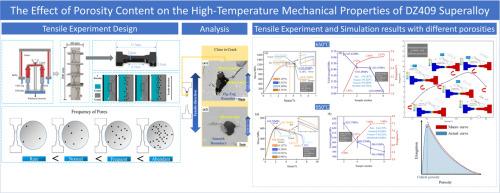The effect of porosity content on the high-temperature mechanical properties of DZ409 superalloy
IF 2.9
Q2 MATERIALS SCIENCE, MULTIDISCIPLINARY
引用次数: 0
Abstract
DZ409 alloy is a new type of directional solidification nickel-based high-temperature alloy, which has excellent comprehensive performance. It can become a candidate alloy for the new generation of heavy-duty gas turbine blade materials that consider multiple properties. However, in the actual production process, shrinkage porosity often occurs in the castings, which seriously affects the mechanical properties. To investigate the effect of shrinkage porosity on the typical mechanical properties of DZ409 alloy in near service conditions (650 °C and 950 °C), Additionally, the tolerance limits of porosity for the basic mechanical properties of the DZ409 superalloy were determined, tensile experiments were designed on DZ409 specimens with different porosity amounts at 650 °C and 950 °C. The results indicate that the influence of micropores on tensile properties is non-monotonic. Furthermore, this non-monotonic influence law was verified through numerical simulation. This result indicates that when the pore content is within a limited range, its impact on the mechanical properties of directional castings is limited. The correlation between shrinkage porosity defects, mechanical properties, and microcracks has been studied, and the corresponding mechanisms have also been discussed.

孔隙率含量对DZ409高温合金高温力学性能的影响
DZ409合金是一种新型定向凝固镍基高温合金,具有优异的综合性能。它可以成为考虑多种性能的新一代重型燃气轮机叶片材料的候选合金。但在实际生产过程中,铸件经常会出现缩孔现象,严重影响铸件的力学性能。为研究近使用工况(650℃和950℃)下缩孔率对DZ409合金典型力学性能的影响,确定了DZ409高温合金基本力学性能的孔隙率公差极限,设计了不同孔隙率的DZ409试样在650℃和950℃下的拉伸实验。结果表明,微孔对拉伸性能的影响是非单调的。并通过数值模拟验证了这种非单调影响规律。这表明,当孔隙含量在一定范围内时,其对定向铸件力学性能的影响是有限的。研究了缩孔缺陷、力学性能和微裂纹之间的关系,并探讨了相应的机理。
本文章由计算机程序翻译,如有差异,请以英文原文为准。
求助全文
约1分钟内获得全文
求助全文
来源期刊

Materialia
MATERIALS SCIENCE, MULTIDISCIPLINARY-
CiteScore
6.40
自引率
2.90%
发文量
345
审稿时长
36 days
期刊介绍:
Materialia is a multidisciplinary journal of materials science and engineering that publishes original peer-reviewed research articles. Articles in Materialia advance the understanding of the relationship between processing, structure, property, and function of materials.
Materialia publishes full-length research articles, review articles, and letters (short communications). In addition to receiving direct submissions, Materialia also accepts transfers from Acta Materialia, Inc. partner journals. Materialia offers authors the choice to publish on an open access model (with author fee), or on a subscription model (with no author fee).
 求助内容:
求助内容: 应助结果提醒方式:
应助结果提醒方式:


